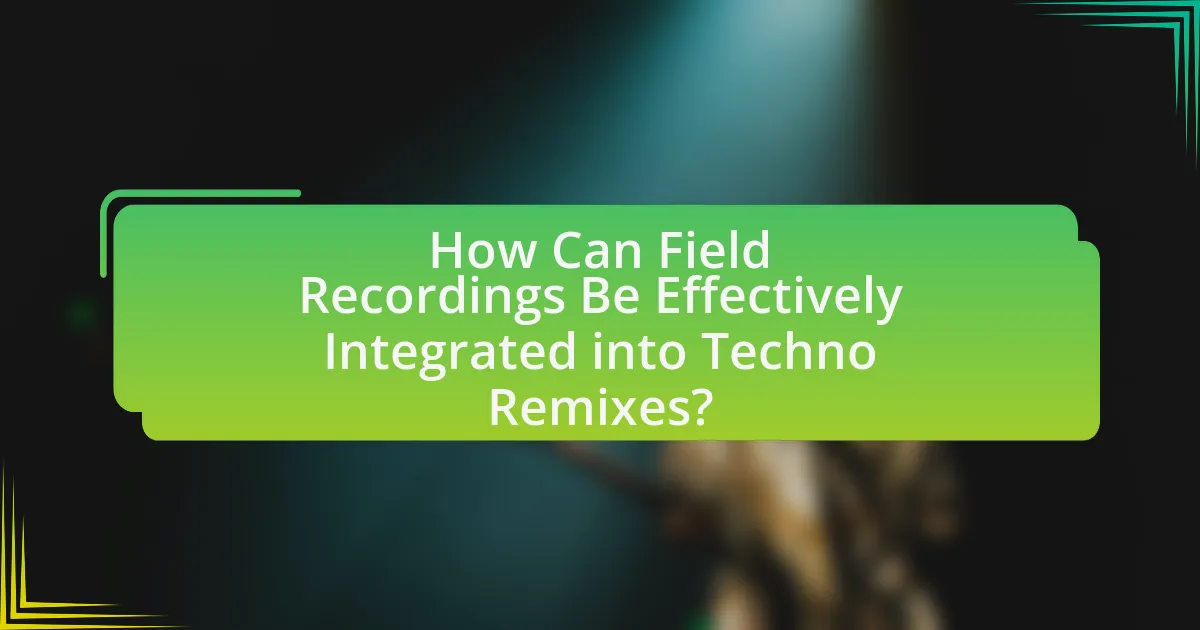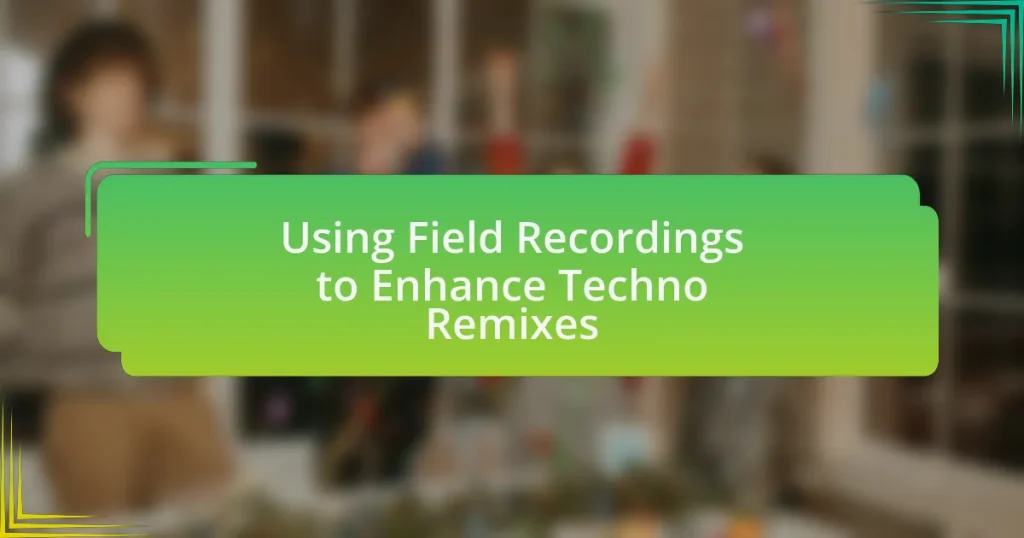Field recordings are audio captures from real or man-made environments that enhance music production, particularly in the techno genre. This article explores how field recordings differ from traditional samples, the types of sounds that can be captured, and their emotional impact on listeners. It discusses techniques for integrating field recordings into techno remixes, including layering and processing, while addressing common challenges such as sound quality and copyright issues. Notable examples of artists and tracks that successfully utilize field recordings are highlighted, demonstrating their significance in expanding the creative boundaries of techno music.

What are Field Recordings and How are They Used in Music Production?
Field recordings are audio captures of natural or man-made environments, often used in music production to add unique textures and atmospheres. In music production, particularly in genres like techno, field recordings can enhance the sonic landscape by incorporating real-world sounds, such as urban noise, nature sounds, or mechanical sounds, which create a more immersive listening experience. For instance, artists like Amon Tobin and The Field have effectively utilized field recordings to blend organic sounds with electronic elements, enriching their compositions and providing depth that traditional instruments may not achieve.
How do field recordings differ from traditional samples?
Field recordings differ from traditional samples primarily in their origin and context. Field recordings are audio captured from real-world environments, often featuring unique sounds that reflect specific locations or events, while traditional samples are typically pre-existing audio clips taken from music, instruments, or sound libraries. The distinctiveness of field recordings lies in their ability to provide an authentic and immersive auditory experience, as they capture the nuances of the environment, such as ambient noise and spatial characteristics. In contrast, traditional samples may lack this contextual richness, as they are often manipulated or looped sounds that do not convey a specific place or moment. This difference highlights the potential of field recordings to enhance techno remixes by introducing organic textures and a sense of place that traditional samples may not offer.
What types of sounds can be captured through field recordings?
Field recordings can capture a diverse range of sounds, including natural environments, urban settings, human interactions, and mechanical noises. These recordings can feature elements such as birdsong, wind, water flowing, traffic, conversations, and machinery. The variety of sounds collected allows for rich auditory textures that can enhance musical compositions, particularly in genres like techno, where atmospheric layers are crucial. For instance, a study by the University of California, Berkeley, highlights how incorporating field recordings into electronic music can create immersive soundscapes that engage listeners on multiple sensory levels.
How can the context of a field recording influence its use in a remix?
The context of a field recording significantly influences its use in a remix by shaping the emotional and thematic resonance of the final piece. For instance, a field recording captured in a bustling urban environment can evoke feelings of chaos and energy, which can be effectively integrated into a techno remix to enhance its driving rhythm. Conversely, a recording from a serene natural setting may introduce a contrasting calmness, allowing for a more introspective or ambient remix. This contextual influence is supported by studies in sound design, which indicate that the origin and environment of recorded sounds can alter listener perception and emotional response, thereby affecting how those sounds are utilized in remixing processes.
Why are field recordings important in the techno genre?
Field recordings are important in the techno genre because they add unique textures and authenticity to the music. By incorporating sounds from real-world environments, artists can create immersive soundscapes that enhance the listening experience. For instance, field recordings of urban environments, nature, or industrial sounds can introduce organic elements that contrast with the synthetic nature of electronic music. This practice not only enriches the sonic palette but also connects listeners to specific places and moments, fostering a deeper emotional response. The use of field recordings has been documented in various techno tracks, illustrating their role in expanding the genre’s creative boundaries.
What unique qualities do field recordings bring to techno remixes?
Field recordings bring authenticity and a sense of place to techno remixes, enhancing the overall listening experience. These recordings capture real-world sounds, such as urban environments or natural landscapes, which can create a unique atmosphere that resonates with listeners. By integrating these sounds, producers can evoke emotions and memories, making the music more relatable and immersive. Additionally, field recordings can introduce unexpected textures and rhythms, adding complexity and depth to the remix. This approach has been validated by artists like Amon Tobin and The Field, who effectively utilize field recordings to create distinctive sonic landscapes in their work.
How do field recordings enhance the emotional impact of a track?
Field recordings enhance the emotional impact of a track by providing authentic soundscapes that evoke specific feelings and memories. These recordings capture real-world sounds, such as nature, urban environments, or human interactions, which can create a sense of place and context within the music. For example, a field recording of rain can evoke feelings of nostalgia or tranquility, while urban sounds can instill a sense of energy or chaos. Research indicates that incorporating these elements can significantly affect listeners’ emotional responses, as they connect with the familiar sounds that resonate with their personal experiences. This connection can deepen the listener’s engagement with the track, making the overall experience more immersive and emotionally resonant.

How Can Field Recordings Be Effectively Integrated into Techno Remixes?
Field recordings can be effectively integrated into techno remixes by layering them as atmospheric elements, creating rhythmic textures, and enhancing the overall sonic landscape. By incorporating sounds from various environments, such as urban settings or nature, producers can add depth and uniqueness to their tracks. For instance, using a field recording of a bustling street can provide a dynamic backdrop that contrasts with the synthetic elements typical in techno. Additionally, manipulating these recordings through effects like reverb, delay, or distortion can further blend them into the mix, ensuring they complement the driving beats and synths. This technique not only enriches the listening experience but also allows for a more immersive connection between the music and the listener’s environment.
What techniques can be used to incorporate field recordings into a remix?
Techniques to incorporate field recordings into a remix include layering, manipulation, and spatialization. Layering involves blending field recordings with existing tracks to create a rich soundscape, enhancing the overall texture of the remix. Manipulation techniques, such as time-stretching, pitch-shifting, and applying effects like reverb or distortion, can transform field recordings into unique sonic elements that fit the remix’s style. Spatialization techniques, including panning and stereo imaging, help position field recordings within the mix, creating a sense of depth and movement. These methods are supported by practices in electronic music production, where the integration of diverse audio sources is common for achieving innovative sound designs.
How can layering field recordings enhance the overall sound?
Layering field recordings can enhance the overall sound by adding depth, texture, and a sense of space to the audio mix. This technique allows for the creation of a more immersive listening experience, as different layers can introduce unique sonic elements that complement the primary musical components. For instance, incorporating ambient sounds from nature or urban environments can evoke specific emotions and atmospheres, enriching the listener’s engagement with the track. Studies in sound design have shown that diverse audio layers can significantly improve the perceived richness of a mix, making it more dynamic and interesting.
What role does processing play in blending field recordings with electronic elements?
Processing is crucial in blending field recordings with electronic elements as it transforms raw audio into cohesive soundscapes. Through techniques such as equalization, reverb, and time-stretching, processing enhances the texture and spatial characteristics of field recordings, allowing them to integrate seamlessly with synthesized sounds. For instance, applying reverb can create a sense of space that aligns the natural ambiance of field recordings with the electronic environment, while equalization can ensure that frequencies do not clash, maintaining clarity in the mix. This approach not only enriches the sonic palette but also fosters a unique aesthetic that characterizes modern techno remixes, as evidenced by artists who frequently utilize processed field recordings to create immersive listening experiences.
What are common challenges when using field recordings in techno remixes?
Common challenges when using field recordings in techno remixes include issues with sound quality, integration with electronic elements, and copyright concerns. Sound quality can be inconsistent due to varying recording environments, which may lead to unwanted noise or distortion. Integration poses a challenge as field recordings must blend seamlessly with synthesized sounds, requiring careful processing and manipulation to maintain the track’s energy and flow. Additionally, copyright concerns arise when using recordings from public spaces or private property, necessitating permission or licensing to avoid legal issues. These challenges highlight the need for technical skill and legal awareness when incorporating field recordings into techno remixes.
How can issues of sound quality be addressed?
To address issues of sound quality, one can utilize high-quality recording equipment and ensure proper microphone placement during field recordings. High-quality equipment minimizes noise and distortion, while optimal microphone placement captures the intended sound accurately. Research indicates that using directional microphones can significantly reduce background noise, enhancing the clarity of the recorded sound. Additionally, employing audio editing software to adjust levels, apply equalization, and remove unwanted frequencies can further improve sound quality. These methods collectively ensure that the final output in techno remixes maintains a professional standard.
What strategies can be employed to maintain a cohesive sound?
To maintain a cohesive sound in techno remixes that utilize field recordings, producers should focus on sound selection, layering techniques, and consistent processing. Sound selection involves choosing field recordings that complement the existing elements of the track, ensuring they share similar tonal qualities and dynamics. Layering techniques, such as blending field recordings with synthesized sounds, can create a unified texture, while consistent processing—applying similar effects like reverb, delay, or EQ across all elements—helps to integrate the sounds seamlessly. Research indicates that cohesive sound design enhances listener engagement and emotional response, as evidenced by studies on auditory perception in electronic music.

What Are Some Notable Examples of Techno Remixes Using Field Recordings?
Notable examples of techno remixes using field recordings include “The Field” by Axel Willner, which incorporates natural sounds to create immersive soundscapes, and “A Mountain of One” by the artist of the same name, who blends urban sounds with electronic beats. Additionally, “Kraftwerk’s” remixes often utilize field recordings to enhance their robotic sound, exemplifying the integration of real-world audio into techno. These examples demonstrate how field recordings can enrich the texture and depth of techno music, providing a unique listening experience.
Which artists are known for their innovative use of field recordings in techno?
Artists known for their innovative use of field recordings in techno include Autechre, Ricardo Villalobos, and Ryoji Ikeda. Autechre incorporates complex soundscapes and environmental sounds into their tracks, creating immersive auditory experiences. Ricardo Villalobos often uses field recordings to add texture and depth to his minimal techno productions, blending organic sounds with electronic elements. Ryoji Ikeda is recognized for his experimental approach, utilizing field recordings to explore the relationship between sound and space in his compositions. These artists exemplify the creative integration of field recordings in the techno genre, enhancing the overall listening experience.
What specific tracks exemplify the successful integration of field recordings?
Specific tracks that exemplify the successful integration of field recordings include “The Disintegration Loops” by William Basinski, which incorporates ambient sounds and environmental recordings to create a haunting atmosphere. Another notable example is “Field Recordings” by Chris Watson, where natural sounds are woven into the fabric of the music, enhancing the listening experience. Additionally, “A Moment of Stillness” by Max Richter effectively uses field recordings of nature to complement its minimalist composition, demonstrating how these elements can enrich techno remixes. These tracks illustrate the effective blending of field recordings with electronic music, showcasing their ability to add depth and context.
How have these examples influenced the techno genre as a whole?
Field recordings have significantly influenced the techno genre by introducing organic textures and real-world sounds that enhance the overall auditory experience. This integration allows producers to create a more immersive atmosphere, bridging the gap between electronic music and the natural environment. For instance, artists like Richie Hawtin and Autechre have utilized field recordings to add depth and complexity to their tracks, demonstrating how these sounds can transform a purely electronic composition into a rich auditory landscape. The use of field recordings has also encouraged experimentation within the genre, leading to innovative remix techniques that challenge traditional techno structures and inspire new creative directions.
What lessons can be learned from these examples for aspiring producers?
Aspiring producers can learn the importance of integrating authentic soundscapes into their music to create a unique auditory experience. By utilizing field recordings, producers can enhance the emotional depth and texture of their techno remixes, making them stand out in a saturated market. For instance, incorporating sounds from natural environments or urban settings can evoke specific feelings and transport listeners to different places, as demonstrated by successful artists who have effectively used this technique. This approach not only enriches the sonic palette but also fosters a deeper connection with the audience, as evidenced by the positive reception of tracks that feature such innovative elements.
What best practices should be followed when using field recordings in remixes?
When using field recordings in remixes, it is essential to ensure that the recordings are contextually relevant and enhance the overall sound. Selecting field recordings that complement the existing elements of the remix can create a cohesive auditory experience. Additionally, manipulating the recordings through effects such as reverb, delay, or pitch shifting can integrate them more seamlessly into the mix.
Furthermore, maintaining a balance between the field recordings and other musical components is crucial; they should not overpower the primary elements of the remix. According to a study by the University of California, field recordings can significantly enrich electronic music when used thoughtfully, as they add texture and depth. Lastly, respecting copyright laws by obtaining necessary permissions for any field recordings used is a best practice that ensures legal compliance and ethical integrity in music production.
How can producers develop their own unique style using field recordings?
Producers can develop their own unique style using field recordings by creatively integrating these sounds into their compositions, which adds distinctiveness and authenticity. By capturing and manipulating environmental sounds, such as urban noise, nature sounds, or everyday objects, producers can create a sonic palette that reflects their personal experiences and artistic vision. For instance, the use of field recordings in techno can introduce unexpected textures and rhythms, setting a track apart from conventional electronic music. This approach has been validated by artists like Amon Tobin and The Field, who have successfully utilized field recordings to create immersive soundscapes that resonate with listeners.
What practical tips can enhance the use of field recordings in techno remixes?
To enhance the use of field recordings in techno remixes, producers should focus on layering, processing, and contextual integration. Layering field recordings with synths and beats creates a rich soundscape, while processing techniques such as reverb, delay, and distortion can transform the recordings into unique textures. Contextual integration involves matching the field recordings to the track’s mood and energy, ensuring they complement the overall composition. Research indicates that well-integrated field recordings can increase listener engagement and emotional response, as demonstrated in various successful techno tracks that utilize ambient sounds to create immersive experiences.


